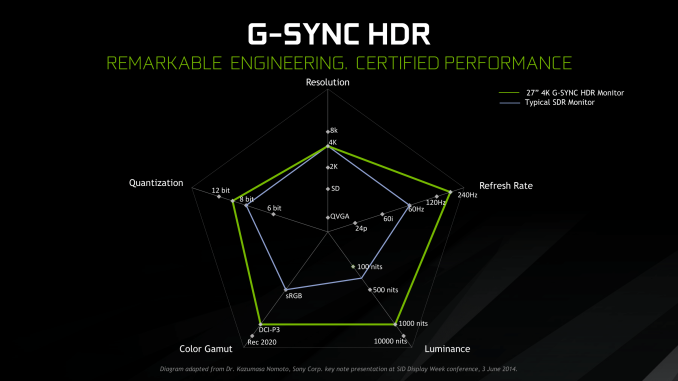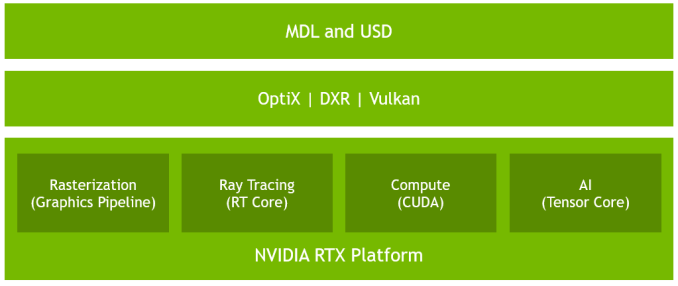The NVIDIA GeForce RTX 2080 Ti & RTX 2080 Founders Edition Review: Foundations For A Ray Traced Future
by Nate Oh on September 19, 2018 5:15 PM EST- Posted in
- GPUs
- Raytrace
- GeForce
- NVIDIA
- DirectX Raytracing
- Turing
- GeForce RTX
Meet The New Future of Gaming: Different Than The Old One
Up until last month, NVIDIA had been pushing a different, more conventional future for gaming and video cards, perhaps best exemplified by their recent launch of 27-in 4K G-Sync HDR monitors, courtesy of Asus and Acer. The specifications and display represented – and still represents – the aspired capabilities of PC gaming graphics: 4K resolution, 144 Hz refresh rate with G-Sync variable refresh, and high-quality HDR. The future was maxing out graphics settings on a game with high visual fidelity, enabling HDR, and rendering at 4K with triple-digit average framerate on a large screen. That target was not achievable by current performance, at least, certainly not by single-GPU cards. In the past, multi-GPU configurations were a stronger option provided that stuttering was not an issue, but recent years have seen both AMD and NVIDIA take a step back from CrossFireX and SLI, respectively.
Particularly with HDR, NVIDIA expressed a qualitative rather than quantitative enhancement in the gaming experience. Faster framerates and higher resolutions were more known quantities, easily demoed and with more intuitive benefits – though in the past there was the perception of 30fps as cinematic, and currently 1080p still remains stubbornly popular – where higher resolution means more possibility for details, higher even framerates meant smoother gameplay and video. Variable refresh rate technology soon followed, resolving the screen-tearing/V-Sync input lag dilemma, though again it took time to catch on to where it is now – nigh mandatory for a higher-end gaming monitor.
For gaming displays, HDR was substantively different than adding graphical details or allowing smoother gameplay and playback, because it meant a new dimension of ‘more possible colors’ and ‘brighter whites and darker blacks’ to gaming. Because HDR capability required support from the entire graphical chain, as well as high-quality HDR monitor and content to fully take advantage, it was harder to showcase. Added to the other aspects of high-end gaming graphics and pending the further development of VR, this was the future on the horizon for GPUs.
But today NVIDIA is switching gears, going to the fundamental way computer graphics are modelled in games today. Of the more realistic rendering processes, light can be emulated as rays that emit from their respective sources, but computing even a subset of the number of rays and their interactions (reflection, refraction, etc.) in a bounded space is so intensive that real time rendering was impossible. But to get the performance needed to render in real time, rasterization essentially boils down 3D objects as 2D representations to simplify the computations, significantly faking the behavior of light.
It’s on real time ray tracing that NVIDIA is staking its claim with GeForce RTX and Turing’s RT Cores. Covered more in-depth in our architecture article, NVIDIA’s real time ray tracing implementation takes all the shortcuts it can get, incorporating select real time ray tracing effects with significant denoising but keeping rasterization for everything else. Unfortunately, this hybrid rendering isn’t orthogonal to the previous concepts. Now, the ultimate experience would be hybrid rendered 4K with HDR support at high, steady, and variable framerates, though GPUs didn’t have enough performance to get to that point under traditional rasterization.
There’s a still a performance cost incurred with real time ray tracing effects, except right now only NVIDIA and developers have a clear idea of what it is. What we can say is that utilizing real time ray tracing effects in games may require sacrificing some or all three of high resolution, ultra high framerates, and HDR. HDR is limited by game support more than anything else. But the first two have arguably minimum performance standards when it comes to modern high-end gaming on PC – anything under 1080p is completely unpalatable, and anything under 30fps or more realistically 45 to 60fps hurts the playability. Variable refresh rate can mitigate the latter and framedrops are temporary, but low resolution is forever.
Ultimately, the real time ray tracing support needs to be implemented by developers via a supporting API like DXR – and many have been working hard on doing so – but currently there is no public timeline of application support for real time ray tracing, Tensor Core accelerated AI features, and Turing advanced shading. The list of games with support for Turing features - collectively called the RTX platform - will be available and updated on NVIDIA's site.













337 Comments
View All Comments
dustwalker13 - Sunday, September 23, 2018 - link
Way too expensive. If those cards were the same price as the 1080 / TI it would be a generation change.This actually is a regression, the price has increased out of every proportion even if you completely were to ignore that newer generations are EXPECTED to be a lot faster than the older ones for essentially the same price (plus a bit of inflation max).
paying 50% more for a 30% increase is a simple ripoff. no one should buy these cards ... sadly a lot of people will let themselves get ripped off once more by nvidia.
and no: raytracing is not an argument here, this feature is not supported anywhere and by the time it will be adopted (if ever) years will have gone bye and these cards will be old and obsolete. all of this is just marketing and hot air.
mapesdhs - Thursday, September 27, 2018 - link
There are those who claim buying RTX to get the new features is sensible for future proofing; I don't understand why they ignore that the performance of said features on these cards is so poor. NVIDIA spent years pushing gamers into high frequency monitors, 4K and VR, now they're trying to flip everyone round the other way, pretend that sub-60Hz 1080p is ok.And btw, it's a lot more than 50%. Where I am (UK) the 2080 Ti is almost 100% more than the 1080 Ti launch price. It's also crazy that the 2080 Ti does not have more RAM, it should have had at least 16GB. My guess is NVIDIA knows that by pushing gamers back down to lower resolutions, they don't need so much VRAM. People though have gotten used to the newer display tech, and those who've adopted high refresh displays physically cannot go back.
milkod2001 - Monday, September 24, 2018 - link
I wonder if NV did not hike prices so much on purpose so they don't have to lower existing GTX prices that much. There is still ton of GTX in stock.poohbear - Friday, September 28, 2018 - link
Why the tame conclusion? Do us a favor will u? Just come out and say you'd have to be mental to pay these prices for features that aren't even available yet and you'd be better off buying previous gen video cards that are currently heavily discounted.zozaino - Thursday, October 4, 2018 - link
i really want to use itzozaino - Thursday, October 4, 2018 - link
i really want to use it https://subwaysurfers.vip/https://psiphon.vip/
https://hillclimbracing.vip/
Luke212 - Wednesday, October 24, 2018 - link
Why does the 2080ti not use the tensor cores for GEMM? I have not seen any benchmark anywhere showing it working. It would be a good news story if Nvidia secretly gimped the tensor cores.